2004 Jeep Cherokee Engine Bay Diagram
The Novak Guide to
Installing Chevrolet & GM Engines
into the
Jeep XJ Cherokee / Wagoneer & MJ Comanche
 One of the most fascinating powertrain conversion platforms among the Jeeps are those into the Jeep XJ Cherokee. Recently, XJ / MJ conversions have gone from being among the more difficult and have become simpler, but not par with the ease CJ & YJ conversions
One of the most fascinating powertrain conversion platforms among the Jeeps are those into the Jeep XJ Cherokee. Recently, XJ / MJ conversions have gone from being among the more difficult and have become simpler, but not par with the ease CJ & YJ conversions
The conversion results can be fantastic.
With improvements in power, fuel economy, reliability and broad range driveability, there is nothing like an XJ with a GM V8.
Before we talk procedure, let's cover a bit of the history of these Jeeps and their key parts that will play a role in the planning of a successful conversion.
A Little History

This installation in this author's own Jeep XJ shows how clean and well a GM LS engine will fit. The power, reliability, fuel economy are nothing short of astounding as compared to the former I6. 0-60? 6 seconds, easy. Fuel economy? 14 MPG's up to 20 MPG's and maybe more if the driver could keep his foot out of the throttle a bit.
In the late seventies, forward thinking AMC engineers and executives began planning and designing an entirely new concept and breed of four-wheel-drive. This new Jeep was to be somewhat roomy, like its namesake Cherokee (the two-door, sportier version in the SJ Wagoneer / J Truck series) but more agile, more compact and more fuel efficient. The result that was delivered in 1983 (for the 1984 model year) was a significant departure from all versions of Jeeps that had come before, though the spirit was much the same. The XJ Cherokee was the first Jeep with unitized body construction, coil spring and track arm front suspension and a set of road manners that made it a broad hybrid. The styling was fresh, with a lower hood line than any previous Jeep, a wide stance and a handsome design.
The new downsized Cherokee weighed in at just over 3,000 lbs. Two and four-door versions were available. There were an extremely limited amount of parts carried over from previous Jeeps. These new Jeeps were offered in three trim levels; the Pioneer, Laredo ('85) and Wagoneer. Later, Stage II and Stage III packages included the Limited, Country and Sport levels.
Factory Engines
The Jeep XJ series can be classified into these major design stages:
Stage I: 1984-1986
Stage II: 1987-1996
Stage III: 1997-2001
The Cherokee itself saw the end of production in 2001, despite continuing great sales. The decision was largely political, with Daimler-Chrysler execs not wanting the XJ competing unfairly with their new KJ Liberty. Of note, the Liberty possesses the "Cherokee" title in Europe.
The XJ was released with two available engines; one being the AMC 2.5L, carbureted four-cylinder with 105 hp. This was AMC's newly designed and released engine, whereas they had used the GM 151 Iron Duke four-cylinder in previous Jeeps. The second engine was the Chevrolet 2.8L V6, also carbureted and rated at 115 hp. Both engines were offered with fuel economy in mind, but they both were meager in their output, and the longevity of the 2.8L have been broadly recognized drawbacks. These engines were available in Stage I XJ Jeeps from 1984-1986. An improved MPI four-cylinder was released for the 1986 model year.
Little argument need be made about why an individual with one of these smaller engines in their Jeep may feel the impetus to upgrade. Of course, the folks at Jeep felt the same way and in 1987, AMC Jeep released a redesigned version of its standard issue straight-six 258 engine. Having been redesigned by Renault and Renix of France (the former having acquired a portion of AMC earlier in the decade), the engine received a shorter stroke, a new head and a computer controlled multi-port fuel injection and ignition system. Power (177 h.p.) and fuel economy nudged up from the 258, and the addition of this engine boosted the XJ powertrain into a somewhat more respectable realm.
With the change to the 4.0 engine, the engine bay of the Stage II Jeep XJ was changed in 1987, including small changes to the firewall, inner fenders and most significantly the front clip. This is one of the key facts that individuals who don't care for large levels of pain and expense should consider, and not make the mechanically dangerous assumption that a 4.0L should swap into a Stage I Cherokee. We at Novak have fielded many a sad call from people who have tried it hoping for a much easier conversion, further supporting one of our leading maxims, that "Jeep parts are often the hardest parts to swap into Jeeps."
The 4.0 remained available and largely unchanged until 1991, when the H.O. version was released, offering better air flow and more refined engine management via Mopar Fuel Injection, replacing the previous Renix system. Horsepower was up 13 points. The latter system was simpler and cleaner, as the evolution of fuel injection goes with most other companies. The last Cherokee 4.0 was built in June of 2001 though it continued in the TJ Wrangler line. Always a good motor, though never wholly exciting, the 4.0 was retired from the Jeep midsize line due to core design drawbacks, including those of long-stroking I6 and the effects that has on power and economy, vis a vis the broader revving power ranges achieved by other fundamentally different platforms like the V6's & V8's.
Factory Transmissions
Transmissions for Stage I XJ Jeeps were the Aisin-Warner AX4 & AX5 as manual gearbox options and the Torqueflite 904 three-speed as the automatic option. All three of these gearboxes (especially the former two) are rated and proven as light-duty.
The Stage II XJ received the AW4 automatic overdrive transmission with the I6 option. The 30RH automatic came with the four-cylinder from 1992-1996.
With the four-speed no longer being available, the Peugeot BA10/5 manual five-speed was the only (fairly pitiful) option in the XJ in 1987-1988. In 1988, a much needed improvement replaced the BA10/5; the AX15. This more durable transmission was the five-speed offered with the XJ through 1999.
Transfer Cases
The 1984-1986 XJ series had two choices of transfer cases. XJ's with Command Trac, Jeep's part-time four-wheel-drive option, used the NP207. The Selec Trac Cherokees & Wagoneers used the part-time/full-time NP228 and NP229.
Stage II XJ's were upgraded to New Process' new NP231 part-time transfer case or the part/full-time NP242 in 1987. These transfer cases remained through the 2001 model year.
Planning the Powertrain Conversion
Transmission Choice
It is crucial to discuss transmissions early on. They are sometimes more central to the conversion than the engine.
In the entire production run of XJ/MJ Jeeps, all transmissions except one should be ruled out when performing a GM engine swap. These include the AX4, AX5 and Peugeot transmissions, which were hardly durable behind the lackluster factory engines. GM power can spell their demise within days to weeks. The AW4 automatic is a stronger transmission, but its computer controls, funky shift points and overall quality when compared with the GM Hydramatics makes it a sub-par choice. The AX15 manual transmission, however, can be successfully retained in a GM engine conversion. Details, below.
Though some of these following transmissions do not offer overdrive, many Cherokees with larger tire sizes and proper axle ratios will still allow for a respectable freeway cruising RPM. An individual is best to perform some gearing calculations as part of this stage of the planning.
Automatic Transmission Options
Most XJ swaps are likely destined to have automatic transmissions. As discussed above, the AW4 is not really a good option:
| TH350: Swappers should surely consider the GM TH350 automatic. The Turbo 350 is strong, compact, widely available and affordable to buy, service and build. • The NP207, NP231 and NP242 transfer cases are adaptable to the TH350 by using our #131 series adapter kits. |  |
| TH700R4 & Early 4L60E : As the TH350 lacks overdrive, many installers will opt for the GM TH700R-4 automatic. The Turbo 700R4 transmission has taken the conversion world by storm and is a good option for the same reasons as the TH350, with advantages in having both a lower first gear and a .75:1 overdrive. Additionally, it is the transmission often coupled with many of the GM TBI & TPI V6 & V8 engines that are the prime candidates for XJ swaps. Note that there are 60 deg. (2.8L, 3.1L, 3.4L & 3800) and 90 deg. (Small Block V6/V8) versions of the 700R4, though the latter is far more common. • The NP207, NP231 and NP242 transfer cases are adaptable to the TH700R by using our #171 series adapter kits. |  |
| 4L60E: The new and most refined version of the 700R4 is the 4L60E, and is a great candidate as well, especially when installed with a Gen. III GM engine and PCM (Powertrain Control Module). If installing a car version of the 4L60E, the driver's side indicator switch should be swapped out for the truck version switch, so that a Park / Neutral safetey switch and reverse light switch are available. • The NP207, NP231 and NP242 transfer cases are adaptable to the 4L60-E by using our #4L61 series adapter kits. |  |
| TH400: In the no-holds-barred strength category, the TH400 may be the obvious automatic of choice. Though more intended for those towing or getting into some rowdier off-roading, the Turbo 400 can be a good option. • The NP207, NP231 & NP242 transfer cases are adaptable to the TH400 by using our #141 series adapter kits. |  |
No adapters are generally needed to marry the above transmissions to their usually matching Chevrolet engines.
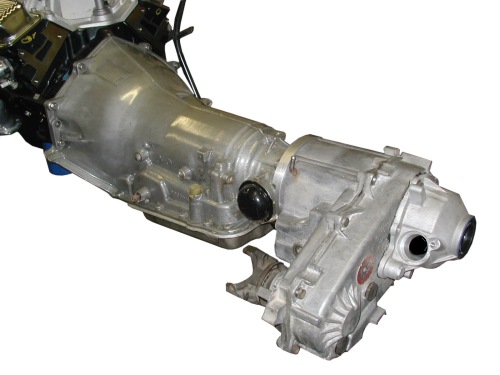
A Ram Jet 350, TH700R4 and Jeep NP231 - loaded and ready for a home between the Jeep's frame rails. The entire assembly can actually be loaded through the engine bay if manipulated carefully.
Manual Transmission Options
The majority of Cherokees & Comanches were equipped with automatic transmissions. If converting from automatic to manual in conjunction with your engine swap, note that the installation of the OEM clutch pedal, master cylinder and related components is not difficult as the provisions to do so are already in place. We will recommend the use of our #HCR3 Hydraulic Slave Cylinder Retrofit assembly on a Chevrolet bellhousing, as it is fully compatible with Chevy engines and the transmissions discussed below.
| AX15: If your Jeep happens to have the AX15 five-speed transmission, you may choose to retain with your GM engine conversion. Though not suited for wild V8 power or punishing off-roading, mild V8's and all around trail/street use make the AX15 good match. Adaptability is not difficult, and is accommodated by our #GMAX series adapter assemblies with the use of your existing GM Muncie/Saginaw style bellhousing. Its overdrive feature can be useful. |  |
Many XJ's are destined for more hybrid or even hard trail use and some individuals will be choosing manual shift, heavy-duty truck four speeds to place behind their GM powerplants. These transmissions do place the shifter stick through through the floor in a postion that is further forward than the native port. As such, they are recommended only for individuals with good fabrication and modding skills.
| SM420: For the old-school, ultra low geared crowd, the SM420 four-speed manual transmission is a great choice. Relatively well behaved on-road and absolutely burley off-road, the SM420 is a cool box of gears. One problem here is that the shifter tower and stick sit too far forward to come up through the console correctly, and a serious bend of the stick will have to be made to clear the underside of the dash. • The NP207, NP231 & NP242 transfer cases are adaptable to the SM420 by using our #421 series adapter kits. |  |
| SM465: Newer and a bit more refined than the SM420 is the SM465, for an only slightly less low geared transmission. They are easy to find and work with. One problem here is that the shifter tower and stick sit too far forward to come up through the console correctly, and a serious bend of the stick will have to be made to clear the underside of the dash. • The NP207, NP231 & NP242 transfer cases are adaptable to the SM465 by using our #461 series adapter kits. |  |
| Ford T18: Yes, the Ford T18 may also be an option for GM swaps. Adapting this transmission to a GM bellhousing is not difficult. One problem here is that the shifter tower and stick sit too far forward to come up through the console correctly, and a serious bend of the stick will have to be made to clear the underside of the dash. • The NP207, NP231 & NP242 transfer cases are adaptable to the T18 by using our #181 series adapter kits. |  |
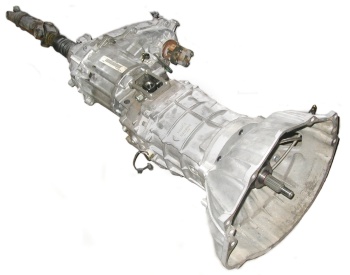
The Chevrolet bellhousing, Jeep AX-15 and Jeep NP231 transfer case married together and ready to lift into the Jeep's tunnel.
Options outside of these mentioned are usually not practical, useful, affordable or any combination of the three. Note that adaptability of the above transmissions to the NP207 transfer case is possible, but may require turning or cutting off the front portion of the hardened input gear for a resulting stick-out dimension of 2.1" long (as measured from the mounting face of the transfer case).
Transfer Case Choice
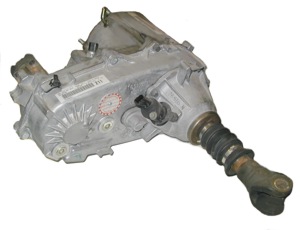
The NP231 transfer case is strong, versatile and your Cherokee may already have one. The NP242 is also a viable option.
Most of the stock transfer cases found in these Cherokees and Comanches are durable and quite appropriate for V8 power. The NP207 has its fans and detractors. Many of our customers choose to replace it with the NP231. The NP242, the full-time / part time case has slightly less torque handling capacity than the NP231 and a more complex design, but it is a decent case and can be retained as well.
Engine Choice
The only two engines we can recommend for installation are, thankfully, two of the best engines ever built:
- The Generation I-II Chevrolet Small Block V8
- The Generation III+ GM Small Block LS (car version) V8
Because of the XJ / MJ low hood, it has to be a low profile engine. This rules out the Chevy V6, and any tall versions of the Chevy V8.
 The GM Gen. III Vortec engines would be candidates, but their high intake manifolds and accessory packages prevent proper installation. While it is true that one can install LS intakes and accessory packages and pulleys onto any of the Vortec engines, this is an advanced project and a potentially expensive one. A native LS engine is a much easier alternative.
The GM Gen. III Vortec engines would be candidates, but their high intake manifolds and accessory packages prevent proper installation. While it is true that one can install LS intakes and accessory packages and pulleys onto any of the Vortec engines, this is an advanced project and a potentially expensive one. A native LS engine is a much easier alternative.
Engine Accessory Configuration
It must be noted here that the accessories package on the engine is important in XJ swaps. LS Camaro and GTO accessory brackets will place the alternator body into interference with the steering gear, and so, the power steering and alternator need to have their locations swapped, like the Corvette versions of this engine. OEM style GM brackets and accessories work fine for this, as to aftermarket bracket kits by KWIK and other manufacturers.
Most Gen I & Gen II engine accessories exhibit good clearance to the Jeep. However, some truck versions of these engines have taller accessories that may interfere with the XJ hood and require reconfiguration.
Air Conditioning Pump
Because of the narrow silhouette of the XJ unibody frame, the typical location of Gen III+ AC compressors on the passenger side skirt of the block will interfere. An air conditioner relocation is required. We've found that the use of a GM R4 compressor with a relocation kit is the best method yet. See this one here.
Factory Gen I-II engines vary more, but generally have easier AC clearance, or plenty of OEM or aftermarket bracket options to choose from.
Engine Oil Pans & Sumps
Once set up with a Vette style accessory package, your LS engine is nearly ready. However, it should be fitted with the Vortec truck style oil pans. These have a higher front sump, and deeper rear sump than the Camaro, Vette and GTO pans, which will interfere with the front axle upon spring compression. Remember to swap the matching oil pick-up, dipstick and tube as well.
Typical rear sump oil pans on Gen I-II engines are ideal and ready for successful installation.
Injected vs. Carbureted
Computers, Wiring and Fuel Injection
Many of us speak nostalgically about the days when engine electrical and fuel systems were about the simplest parts of an engine swap. Engine and vehicle management computers are now a major part of modern automotive systems, and therefore, a significant concern when doing a conversion. Some run from these issues, and others embrace them. What must be said for modern powerplants is that they are efficient, cleaner and in many cases, more powerful. What's more, many state and county emissions laws require these modern systems in modern swaps. In a word, computer controlled engines are here to stay. The neat thing is that there are good resources available to facilitate this process.
This question has been at the forefront of the conversion world for a while now. There is something great about a simple, clean, unencumbered carburetor and simple ignition system. However, there is something excellent about a modern, self-adjusting, efficient, operate-at-any-camber fuel and spark delivery system.
No doubt that many individuals are in their comfort zone with the earlier hardware, but distill it down to the basics and it is the same essential thing that was going on in 1903; getting fuel and spark into the cylinders with the right mix and timing. There is no way around the conclusion that fuel injection systems do this better and in a broader range of conditions. Old iron is really cool, but this author has lived squarely during both carbureted and injected eras, an I see fewer breakdowns than ever, and have been in the bays and at the wheels of enough injected vehicles to know that they use less fuel to generate more power and in a cleaner, more reliable manner than their predecessors.
We get an occasional call from customers that have found a beautiful LS V8 and ask if they can put a "simpler" carburetor on it. This has every distinct disadvantage that we can think of: increased parts cost, decreased efficiency, driveability and reliability. Don't even think about it. Fuel injection (especially GM fuel injection) is much easier to work with than too many people think.
That being said, choose what you want. Unless, of course, you have emissions restrictions...
Emissions
This topic is covered inthis separate article, here.
What to Pull From a Salvage Powertrain
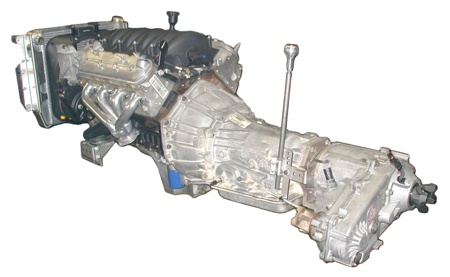
Or... get a fully integrated powertrain for your XJ. Our setup will give you an assembled, tested and simplified powertrain to connect into your Jeep. See them here...
There is simple and specific strategy to pulling an engine or engine/transmission combo from the salvage donor vehicle for the best results for your Jeep conversion.
- You need four or five key things:The engine (don't let the obvious escape you).
- The accessory package and its brackets. The latter is especially important in that you don't want to waste valuable time and money chasing down the bracketry. The three major GM accessories that are native to the engine that you will install into your Jeep are the alternator, power steering pump and perhaps the air conditioner pump.
- The computer PCM or ECM that controls the motor (and possibly the automatic transmission) combo)
- The powertrain wiring harness. This is where individuals get unnecessarily uptight. This harness is quite obvious and surprisingly well self-contained. You will want all circuits to the engine's sensors and controllers, and you may opt to include the GM Power Distribution Center, also known as the relay center.
- The automatic transmission that is married to the engine. It is very helpful to keep your (usually) 4L60-E transmission attached to its engine and computer. As a matched set, your installation will usually be simpler and your performance will be better.
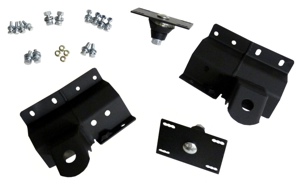
This is usually how the engine is shipped by the pros and it is salvage industry standard to include the above, with the exception of the accessories in some situations.
Engine Placement
For the XJ, this is the easy part. Our engineeredengine mounts will put your Gen. I-II Chevy V8 or your Gen. III+ LS V8 in precisely the right location. We've used multiple Jeeps, multiple engines and many installations to find the perfect locations. The installer's responsibility is to just install the mounts and engine as intended.
Cooling
It will be little news to most readers that the factory radiator will not work with a conversion engine both in terms of cooling capacity and outlet location. Novak started swapping V8 engines into XJ Jeeps a few years ago and setting up a cooling system was a stifling challenge. Since then we now offer a bolt-in performance aluminum radiator with the outlets already configured for GM power. See our Cooling Components section to view the line-up.
 Our XJ / MJ radiators totally eliminate the old, problematic, remote pressure bottle system and provided a standard filler neck. Your engine bay will look much cleaner and the risk of damaging air pockets is significantly reduced.
Our XJ / MJ radiators totally eliminate the old, problematic, remote pressure bottle system and provided a standard filler neck. Your engine bay will look much cleaner and the risk of damaging air pockets is significantly reduced.
As engine choices vary, you will need to choose your cooling hoses from amongst those on hand at your local parts source, whose length and curves are based off wire bent templates you can fashion.
We are unaware of any OEM radiators that will work without some extensive modifications. Additionally, the short grille of the XJ calls for an aluminum radiator that dissipates heat faster than the copper / bronze versions.
Electrical
 Powertrain Control Modules
Powertrain Control Modules
The PCM is an enclosed industrial-grade computer that, like most computers, has a processor, memory and IO connections. Newer PCM's use an EEPROM chip; they are Electrically Erasable. This is also called flash ROM, and some users will equate this to the BIOS chip on their PC computer motherboard.
The computer works on if/then data tables and mathematical formulas in the ROM to interpret data streaming in from engine and vehicle sensors, including speed, temperature, exhaust O2, intake air flow, throttle position, crankshaft/cam position, brake, etc. The culmination of these data is processed to provide optimum fuel/spark delivery and in many cases, automatic transmission shifting points. Speed and rev limiters are also incorporated into some units. Once called an Engine Control Module (ECM), these computers have been appearing in vehicles since the early to mid-eighties. Their initial functions leaned more towards carburetor control primarily to keep up with tightening emissions standards. This was a bit of a dark time in automotive systems engineering as these early systems are now mistrusted to a degree by owner and mechanic alike.
Modern PCM's have evolved to be highly reliable, very functional and it is not difficult to integrate them into the Jeep engine bay with your new motor.
Some installations require PCM reprogramming. This is a service that is much more available for GM computers than any other, often through GM dealers, or local and national tuning shops.

This is the Jeep's (1996 & later) OBDII DLC data plug, compatible with any onboard diagnostic reader. Your choosing of a 1996 or later Chevrolet or GM engine will allow you to connect this port to your GM computer.
We are amused by companies claims and inferences that the installation of Dodge V8 engines only allows retention of this feature or the "factory serviceable" status. Any shop (or home mechanic with a DLC reader) worth its salt can service and diagnose your GM engine in your Jeep's bay, and likely with greater ease and flexibility than with any other powerplant available.
Some view the electrical and wiring aspects of a conversion as the 800 lb. gorilla of the swap. In fact, it is seldom as difficult as perceived, especially when working with GM power.
At the most fundamental level, whether you are working with a carbureted, throttle body injected or multi-point ("tuned port") injected engine, you will retain and connect the original GM alternator in the same manner as was the Jeep alternator; the same for the distributor, etc.
From basic (TBI) to advanced (TPI & Gen. III) injection systems, the swaps are still largely the same.
For fuel injected swaps, you should know that the engine and its PCM are largely self-supporting. In other words, the very grand majority of the engine wiring harness goes to (sensor data) or comes from (systems control) the PCM, and most sensors are directly related to the engine itself. If uninstalled correctly, most of this harness will be intact and not needing any splicing. Like any electrical item, the computer needs power and ground, and a power distribution center (largely consisting of relays and bridges - you can keep the Jeep one!) to switch and of course, distribute power to the various systems.
The installer should keep one simple principle in mind: make the engine think it is running in its original GM chassis. A simplistic but fair summary would state that a 1955 Chevy 283 and a 2004 LS1 have the same basic wiring requirements; power to the starter when it is required, power to the distributor (or coils) when needed. The battery needs power from the alternator to keep it charged.
An installer's analysis of the Jeep's particular wiring diagram and the engine's wiring diagram will quickly reveal the wires that can be merged, connected and (in many cases) simplified or even eliminated.
Gauges
In 1996, coupled with the advent of the OBD-II standard, Jeep also introduced a fully electronic gauge cluster. The six gauges have one integrated microprocessor that receives a multiplexed signal from the PCM. This digital signal cannot be generated without the Jeep computer. There are two ways to get around this: the first and best is to upgrade the Jeep cluster to an aftermarket set that is fully GM compatible. The fuel level meter should be Chrysler compatible since you will be using the signal from the factory fuel sender. In the end, this may be a better method due to the accuracy, adjustability (especially important for the speedometer on Jeeps with varying tire sizes and axle ratios) and custom look.
The second way to circumvent this challenge is to run the Jeep computer (ECM) in tandem with the GM powertrain computer. This consists of applying source voltage to the Jeep unit and then feeding the varying (oil pressure, water temp, voltage, etc.) signals into it to be processed and multiplexed to the original gauge panel. The tachometer can now be rendered operation by using the Novak Crank Position Emulator module.
Steering
Installers will be pleased to hear that steering need change none or very little to perform the engine conversion. You will use a GM power steering pump that is native to the engine being installed.
You will retain the factory Jeep power steering gear. You may need the assistance of a hydraulic shop to have the high pressure (supply) hose ends matched or adapted as per your pump and gear combo. Usually the low pressure (return) line can be cut from hose stock and secured with the use of hose clamps.
Suspension & Engine Weight
You'll be replacing one of three factory engines. Their nominal estimated, accessory loaded weights are:
- 2.5L I4, 340 lbs.
- 4.0L I6, 515 lbs.
Engines you may replace these with may include:
- Chevy Small Block V8 (Gen. I & II), 550 lbs.
- GM Small Block V8 (Gen. III), 525 lbs.
- GM Small Block V8 (LS1), 407 lbs.
Numbers aside, if you are replacing an I6 with a V8, use a front spring that is rated for the I6. The numbers are close enough that it comes out very nicely.
Now the other big question: do I need to lift my XJ to accommodate the new engine? We recommend that you do. It will also offer more clearance for the upper track arms. Nothing drastic need occur, but 2" of lift can make a sizeable difference in the freedom of engine placement and this amount of increase (2"-3") does not require changes to the front track arms. Bump stops will be necessary to prevent the front driveshaft from intefering with the driver's side exhaust circuit.
If nothing more, a bit of lift looks good, especially considering that many factory springs get saggy with age.
Fuel Delivery
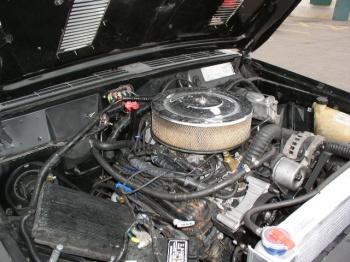
A 1984 XJ Cherokee with a TBI Chevrolet V8 and a 700R4 automatic transmission. One of our first XJ conversions, this Jeep had enough get-up-and-go to widen our eyes.
Fuel pumps have evolved from low pressure (4-12 PSI) mechanical, engine mounted units for carburetors - good at pulling fuel over a distance - to medium pressure (13-18 PSI), electric in-tank pumps for throttle body engines, to high pressure, electric, in-tank pumps. These latter pumps are designed to push fuel, not pull it, and at pressures ranging from 38-65 PSI for multi-point injections systems.
Additionally, with the higher temperatures that these high-pressure pumps generate, their immersion into the cooler fuel is critical for the durability of its electric motor. External pumps of the same ratings are available and are self-cooled by being built into heat dissipating aluminum housings.
Since GM injected powerplants are usually more efficient engines, fuel volume would probably not exceed that of the 2.5 & 4.0L, and would certainly not exceed the OEM pump's volume capacity.
Natively, the in-tank XJ pump will generate 90 psi. for all 1987 and later models. The installation of an aftermarket regulator to bring it down to the PSI your fuel-injected engine requires is easy to install. If you are running a carbureted engine, regulating down from 90 psi to ~4 psi is too dramatic, and the installation of a low pressure electric fuel pump (in-tank or external) is recommended.
For 1997-2001 XJ's, Novak offers its #FSK-9704 fuel system integration kit to simplify this procedure for these in-tank regulated Jeeps.
Exhaust
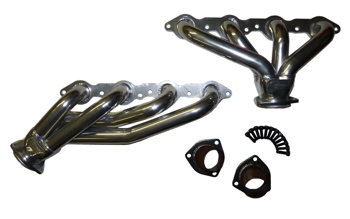 No doubt that getting exhaust air out of the engine is a more elaborate process than getting combustible air in.
No doubt that getting exhaust air out of the engine is a more elaborate process than getting combustible air in.
For the Gen. I-II Small Blocks, choose our #CC158 series headers.
For the Gen. III+ V8, choose our #CCXJ3 headers.
Garner the services of a local exhaust shop to help you put together a clean, safe, easy flowing exhaust system and one in accordance with your local regulations. If you are running a TBI, TPI or Gen. III+ engine, you will also need to have O2 (oxygen) sensor bungs - typically one per bank - welded into the down pipes below the headers. California installations will need to utilize a manifold / header that is CARB certified.
While the XJ has a relatively narrow window in which to run pipes, and a transfer case to dodge as well, you can run dual exhaust. However, we suggest running the driver's side exhaust circuit under the rear wall of the oil pan and in front of the transmission/bellhousing face, into a Y-pipe joining it with the passenger side circuit. You can also run this Y behind the transfer case (give yourself some room to service the transfer case later) and then into the exit circuit. From there, run rearward to the catalytic converter and then the muffler, following which, you will arc the last section of pipe up over the rear axle and then straight out the back with the tailpipe. 2-1/2" diameter pipe is usually very adequate and will flow as much as you need. 3" is an option.
Leave the factory heat shielding in its location and position your catalytic converter and muffler under it.
Muffler choice is up to you, and possibly your passengers, neighbors and local noise ordinances.
Driveshafts
Another inordinate concern too many people have is about driveshafts. This is one of the smallest of the challenges facing the installer in an XJ project.
Most factory transmission and adapter combinations to the 231 (or other transfer cases) vary. As such, it is often that driveshaft lengths will need to be changed to accommodate the swap. Also, consider that there multiple ways to install a conversion engine and the following will be of note:
It is seldom a good idea to allow the driveshafts to make the decisions as to where the powertrain will be placed. Some of our customers, fearful at the perceived expense of new or modified driveshafts, attempt to let the existing driveshafts dictate engine, transmission and transfer case location, sometimes to the detriment of the project. Driveshaft modifications are usually inexpensive when performed by driveline, RV or tractor implement specialists. New driveshafts are an option but seldom a requirement in regards to the actual successful conversion. Jeeps that require extensive travel or specialty-built driveshafts have this option available through several fabricators across the nation.
Crossmember & Rear Mount

This popular rear mount is strong and easy to set up with any Jeep swap, including the XJ. See our lineup of rear mounts, here.
There are only three major places a powertrain needs support and mounting. Two at the engine, and one under the rear of the transmission (some transfer cases have the provision for a side mount to help control torque kick-back). Nearly all Novak adapters have cast-in or modular mounting bases that are configured for use with an industry standard urethane rear mount.
There is no need whatsoever, in terms of the engine & transmission swap, to use a different crossmember than the factory versions. They are typically low profile and can easily be redrilled for a new transmission mount unit. Unless you are retaining an AX15, getting rid of the factory urethane mount and any ancillary bracketry with it is the largest favor you will do for yourself in this area. Go with a clean, simple, industry standard mount like the Novak #RMU. You may need some simple spacers. Box steel or aluminum pucks are useful here. Anything needing to be fabricated needn't be elaborate.
Axles
Many people mistakenly think that a more powerful engine demands stronger-than-stock axles. This is not necessarily the case. The factory Dana 35 and Dana 44 rear axles (the latter usually being found on towing package option Jeeps) can withstand very ambitious engines. Such is the case for the front Dana 30 as well. Whether your converted XJ needs stronger axles is more a question of how you use them, and usually in terms of off-road considerations more than on-road use.
Axles are generally out of the scope of our work here at Novak, but there are plenty of companies that deal with them to be of assistance if you feel you must upgrade them as part of your conversion.
Linkages
This topic generally covers throttle, clutch release and transmission & transfer case shifter systems. As with many aspects of a swap, this can be a simple as the installer would like it to be. As nearly all modern Jeeps and GM engines use sheathed cable for throttle control. More Generation III engines use a throttle-by-wire, in which case you will use the GM pedal, and connect the wiring as per OEM.
Transmission and transfer case shifters are discussed in instructive detail in the Novak instruction packages that will come with your gearbox adapter assembly, and specifically to your particular drivetrain choice for your Jeep.
Brakes
A stronger engine means faster acceleration and sometimes the ability to tow, as the XJ's chassis is rated to tow up to 5,000 lbs. However, the ability of the Jeep's brakes to bring things to a safe halt may be below what it should be.
As a general rule, if the brakes were good before the swap, they will probably adequate after the swap. However, many XJ's, especially those prior to 1990, had weak brakes from the factory. It is up to the individual doing the conversion to ascertain whether or not to upgrade the braking system. Brake systems are out of Novak's scope, but there are companies and shops that deal with brake upgrades, usually involving larger discs & drums, four-wheel discs, occasional master cylinder upgrades, etc.
Summary
This article is meant to be introductory and to give the reader an idea of the scope of a conversion project. No two swap combinations are ever exactly the same, but an understanding of the principles and parts involved will take any thoughtful installer a long ways. As discussed in this guide, further and more deeply detailed information comes with Novak adapter assemblies, engine mounts, radiators and other components. Additionally, our customers can speak with our Techs about the conversion being performed.
All in all, there is no change to your Jeep that is more exciting or beneficial than a powertrain conversion. Individuals have been swapping GM power into Jeeps for decades and they still occur with frequency and great success.
Posted by: lincolnwielguse0197761.blogspot.com
Source: https://www.novak-adapt.com/knowledge/engines/swap-guides/chevy-buick-gm/xj-swap/
Post a Comment for "2004 Jeep Cherokee Engine Bay Diagram"